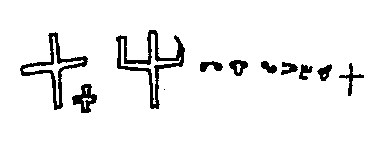
Inscription, discovered in the Round church in Preslav.
Publications: Inscriptions from the Round church in Preslav. S., 1981. E. Georgiev. Our AZ-BUKI-VEDI, p. 101. Facsimile.
1. 
Inscription, discovered in the Round church in Preslav.
Publications: Inscriptions from the Round church
in Preslav. S., 1981. E. Georgiev. Our AZ-BUKI-VEDI, p. 101. Facsimile.
Transcription:
In second section, which is written with Glagolic letters, one reads
quite clearly the word TIGJUBA, which resembles the Celtic word tingju
(holy) and tigijow (peace). The proposition of some researchers
that it is an abbreviation of STI GI BZHE (holy lord God!) is hard to accept
for such an inscription, as the ending letter A in TIGJUBA compromises
this interpretation. Additionally, nowhere is to be seen the characteristic
for such abbreviations initial letter S. Still greater difficulties raise
the first two large characters. The first of them is probably the symbol
of the cross, but it could be the Glagolic A as well. The second character
is still more mysterious, in a certain way it resembles the Greek letter
PSI, which is not characteristic for the Glagolic alphabet (see
E. Georgiev. Op.cit., p. 37). If we look at the Proto-Bulgarian
runic inscriptions from Murfatlar, we will see the same character used
for writing the letter of H. This character is found exactly where the
word for Christ must be (see Supplement
6, Inscription 2).
Translation:
THE CROSS OF CHRIST THE HOLY
2. 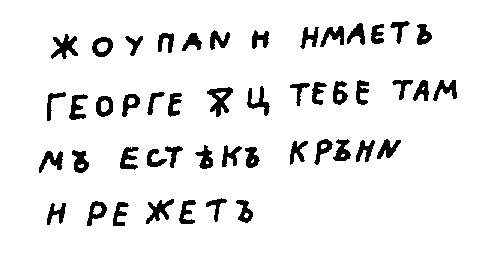
The inscription was discovered in Murfatlar and is published
only by Barnea and Stefanescu (see D. Barnea, I. Stefanescu. Din istoria
Dobrodcei, t. III, 1971, Fig. 63).
Transcription:
ZHUPAN I IMAET GEORGE ONC TEBE ESTEK KRAIN I REZHETE
Translation:
THE ZHUPAN AND GUARDIAN GEORGE PROMISES YOU EIGHTY PIECES OF GOLD AND
SO MUST IT BE!
The text is a mixture of Slavic and eastern Iranian (Pamirian) words. That is why some of the them are of the root as the words of the previous inscription. Thus, for example, the inscription containing the word Tongan has the ordinal number ES (eight) used, and in this inscription we meet its derivative ESTEK (eighty), still used by the Pamirian, Dardic and Celtic peoples. The rest of the details of the translation are mentioned further above. This inscription convinces us about the fact that the mutual influence (convergence) between the Proto-Bulgarian and the Slavic language was a real historical process, which formed the modern Bulgarian language.
3. 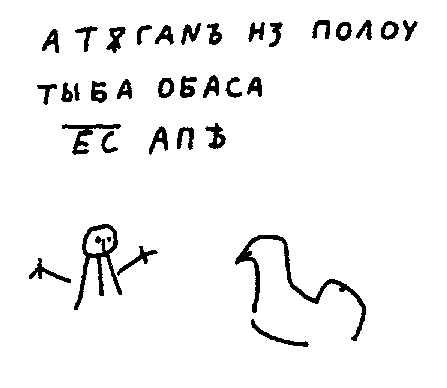
Inscription, discovered in one of the four small rock churches in Murfatlar.
Publications: D. Barnea, I. Stefanescu. Op.cit.,
Fig. 63.
Transcription:
A TONGAN IZ POLOU TUIBA OBASA ES APE
Translation:
AND TONGAN FROM POLOU PROMISED YOU EIGHT SHEEP
The text is a mixture of Proto-Bulgarian and Slavic words. Of Slavic origin are probably the prepositions A and IZ, and the word TUIBA, and of Proto-Bulgarian origin - TONGAN, OBASA, ES, APE. Details of the translation are mentioned in the text above. With the exception of the personal name Tongan, almost all of the words are met in the eastern Iranian (Pamirian) and Celtic languages. The mixing of the languages reminds strongly of the passage from the Rila monastery, quoted below.
4. 
Inscription of Dimiter Zhupan with Proto-Bulgarian runic characters
between the Cyrillic letters.
Publications: St. Vaklinov. The formation of the
Old Bulgarian culture. S., 1977, p. 225.
5. 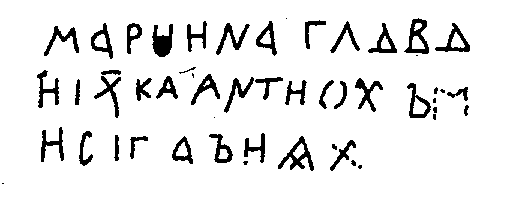
Preslav. The church of Mostich. Cyrillic inscription with Proto-Bulgarian
runic characters between the letters.
Publications: St. Vaklinov. The formation of the
Old Bulgarian culture. S., 1977, Supplements.
5.a. Mixed Proto-Bulgarian - Slavic text, discovered in the Rila monastery.

Transcription:
"TRII SUT VELIKII DOBRODETELI VERA NADEZHDA I LJUBII.
NO NADEZHDU OUBO I LJUBI. ELMA VESHU OSMA DNE. MALA RECHEM.
DOWERII HASHE RASHINEKAA.. "
Translation:
Three are the greatest virtues - faith, hope and love.
But the hope, however, love you. First month, eighth day. Here we will
say.
The confidence is better than the light."
This special text, containing both Slavic and Proto-Bulgarian words, was coincidentally discovered in the Rila monastery. It appears at the start of a text dedicated to the three Christian virtues - faith, hope and love.
Publications: P. Dobrev. The Proto-Bulgarians...,
p. 98-99.
Notes to the translation. The expression ELMA VESHA meant in Proto-Bulgarian
"first month" (viz. the Proto-Bulgarian word ELEM - first, and the Iranian,
Caucasian word "VESH" - month) and words such as MALA (here), HASHE (better)
and RASHINEKAA (light, fire) are met even nowadays among the peoples of
the Pamirs. The expression "First month, eighth day" marked the day of
celebration of Faith, Hope and Love.
6. Mixed Old Bulgarian inscriptions from Murfatlar, with Proto-Bulgarian characters in some places.
6.1. 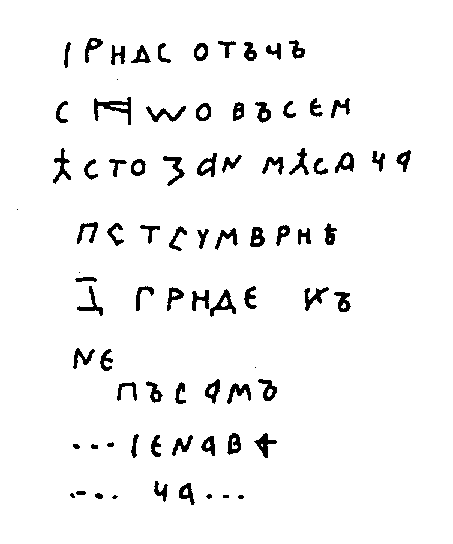
Publications: D. Barnea, I. Stefanescu. Op. cit.,
Fig. 62 (1).
6.2. 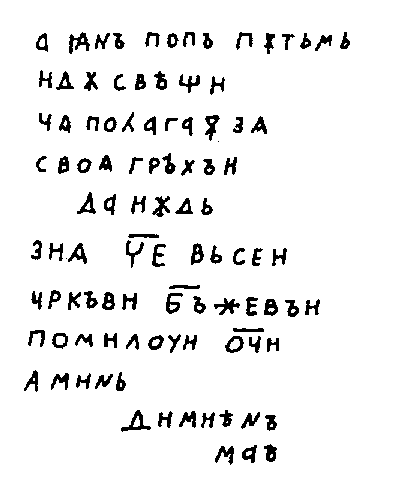
Publications: D. Barnea, I. Stefanescu. Op. cit.,
Fig. 61.
7. Old Bulgarian inscriptions with interspersed Proto-Bulgarian characters.
7.1. 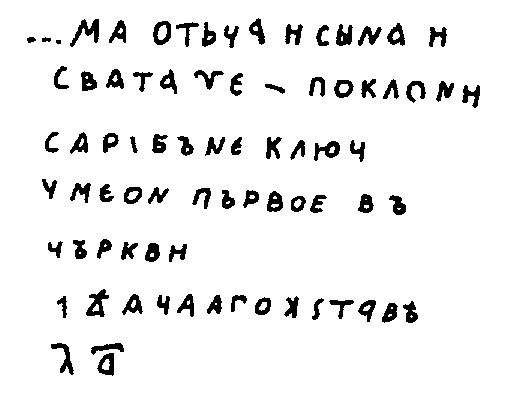
Publications: D. Barnea, I. Stefanescu. Op. cit.,
Fig. 62 (2). The inscription was discovered in Murfatlar.
7.2. 
Publications: K. Popkonstantinov. Two Old Bulgarian
inscriptions from Preslav. - Centuries. 1980, Book 4. p. 28.
[Previous] [Next]
[Back to Supplements]